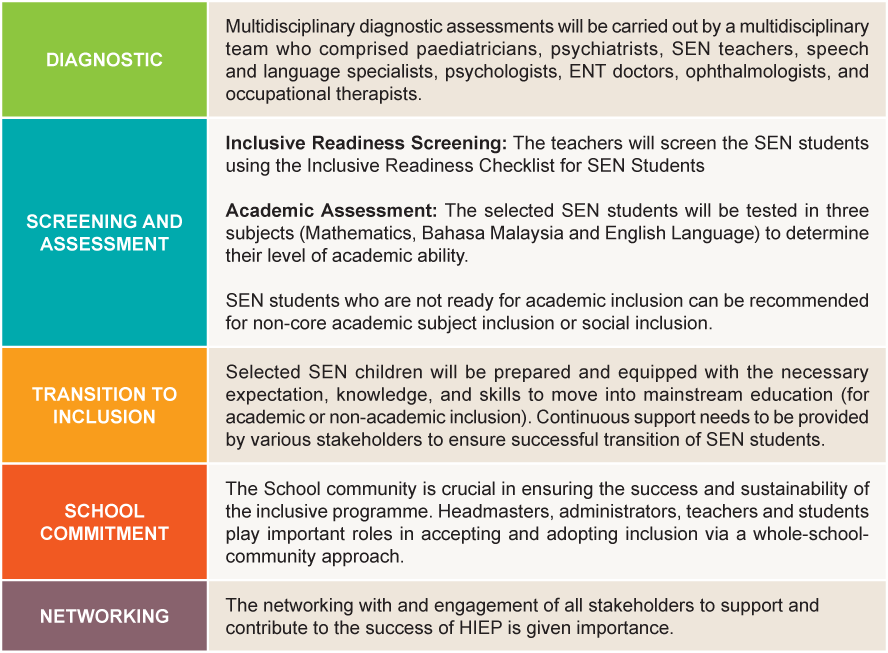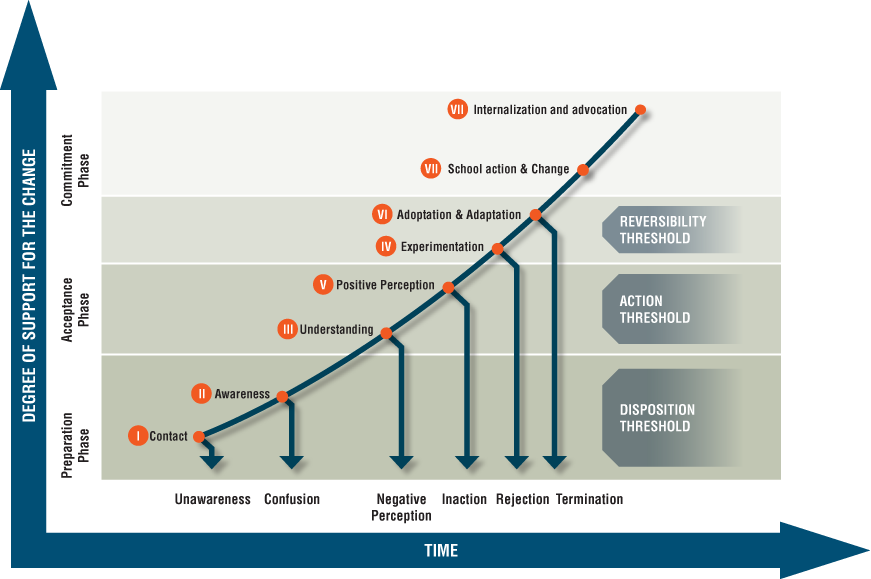HIEP PROGRAMME
Introduction
Of the estimated 500 million persons with disabilities world-wide, 120-150 million are children (United States Agency for International Development, 2010). The recorded number of SEN students in Malaysia stands at 54,000 in 2012 and the enrollment of SEN students have doubled in the last five years (PEMANDU, 2013). These students are provided with special education through Special Schools and Special Education Integrative Programmes. The law requires that the SEN students be placed in the least restrictive environment, but it is not mandated for them to be in a full inclusion setting. Even though inclusive education programmes for SEN students in Malaysia had started in 1988 as a pilot project which involved 14 schools, only about 7.5% of SEN students are placed in inclusion programmes at mainstream schools (PEMANDU, 2013).
The Government has a long term goal of increasing the number of special needs students in inclusive schools while at the same time recognizing this approach may not be applied to all SEN students. Inclusion will improve region the ability of students with special needs to be involved with and to contribute to the society and economy as adults. Research from the Asia Pacific Region a shows a setback of 15.6% in a country’s GDP if people with special needs are not participating in the country’s economy. Hence, there is a need to increase the number of SEN students through a holistic and sustainable inclusive programme.
Route to Inclusion
The route to holistic inclusion is depicted in the flowchart below. It begins with diagnostic, inclusive readiness screening, academic assessment, transition, school community and finally ending with networking with stakeholders.


Figure 1 : Route to Inclusive
HEIP employs a “Whole-School-Community Approach” in which all key stakeholders identified) will be engaged and their points of view will be included to ensure effective integration of SEN objectives

Figure 2 : Key Stake Holders identified in HIEP
Figure 3 shows the developmental phases towards HIEP. In order to successfully implement the programme, all key stakeholders need to go through three phases of transformation: (1) Preparation, (2) Acceptance and (3) Commitment (Conner, 2011; Conner & Patterson, 1982; Mecca, 2004).
Each phase represents a juncture critical to the development of commitment towards the inclusive programme. A successful transition through a particular phase serves as the basis for achieving the next phase.

Note : The vertical axis represents the degree of support for the new mindsets and behaviours, and the horizontal axis reflects the passage of time.
Preparation Phase: All stakeholders need to be exposed to the basic knowledge, rationale and benefit of inclusion to create awareness about HIEP.
Acceptance Phase: All stakeholders understand the significance of inclusive educ\ation and have positive perceptions about its implementation at mainstream schools in Malaysia. There should be a paradigm shift from seeing the programme as externally imposed to seeing it as having a personal relevance. This perspective enables stakeholders to make decision about accepting or not accepting their roles in the programme.
Commitment Phase: All stakeholders are committed to make a change as they see the programme as more positive than negative and take action accordingly. There are four substages in the Commitment Phase namely experimentation, adoption and adaptation, school action and change, and finally internalization and avocation.
Experimentation: No matter how positively stakeholders view a change prior to engaging with it, their actual experience with it will reveal a number of small or large surprises. Some of these may be positive, but others may involve unanticipated challenges. An environment that encourages the open discussion of concerns will help to solve problems, promotes ownership, and builds commitment for HIEP.
Adoption and Adaptation: Stakeholders will adopt the inclusive programme after they have successfully navigated the initial trial period. Best practices will be adapted to the local context to best meet the learning needs of individual SEN student.
School Action and Change: This sub-stage reflects the action taken by the school community to implement and promote HIEP. Some organisational structure may be altered to champion for the new mindsets and best practices on inclusive education.
Internalization and Advocation: Internalization demonstrates the highest level of commitment that stakeholders could demonstrate. It reflects an internal motivation, beliefs and desires to implement HIEP. One’s enthusiasm and persistency to promote practices on inclusive education could become infectious and ultimately such lead to advocacy and promotion of inclusive programme to a larger community.
| AWARENESS SEMINAR |
|
| PROFESIONAL DEVELOPMENT TRAINING |
|
| ASSESSMENT AND DIAGNOSIS BY MULTIDICIPLINARY TEAM |
|
| SCHOOL SCREENING |
|


